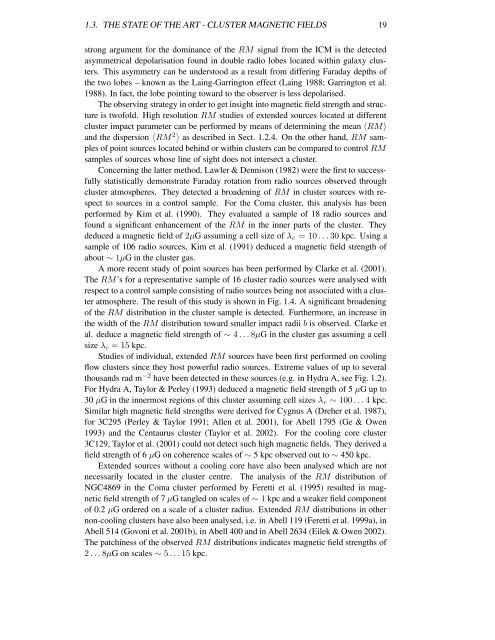Investigations of Faraday Rotation Maps of Extended Radio Sources ...
Investigations of Faraday Rotation Maps of Extended Radio Sources ...
Investigations of Faraday Rotation Maps of Extended Radio Sources ...
You also want an ePaper? Increase the reach of your titles
YUMPU automatically turns print PDFs into web optimized ePapers that Google loves.
1.3. THE STATE OF THE ART - CLUSTER MAGNETIC FIELDS 19<br />
strong argument for the dominance <strong>of</strong> the RM signal from the ICM is the detected<br />
asymmetrical depolarisation found in double radio lobes located within galaxy clusters.<br />
This asymmetry can be understood as a result from differing <strong>Faraday</strong> depths <strong>of</strong><br />
the two lobes – known as the Laing-Garrington effect (Laing 1988; Garrington et al.<br />
1988). In fact, the lobe pointing toward to the observer is less depolarised.<br />
The observing strategy in order to get insight into magnetic field strength and structure<br />
is tw<strong>of</strong>old. High resolution RM studies <strong>of</strong> extended sources located at different<br />
cluster impact parameter can be performed by means <strong>of</strong> determining the mean 〈RM〉<br />
and the dispersion 〈 RM 2〉 as described in Sect. 1.2.4. On the other hand, RM samples<br />
<strong>of</strong> point sources located behind or within clusters can be compared to control RM<br />
samples <strong>of</strong> sources whose line <strong>of</strong> sight does not intersect a cluster.<br />
Concerning the latter method, Lawler & Dennison (1982) were the first to successfully<br />
statistically demonstrate <strong>Faraday</strong> rotation from radio sources observed through<br />
cluster atmospheres. They detected a broadening <strong>of</strong> RM in cluster sources with respect<br />
to sources in a control sample. For the Coma cluster, this analysis has been<br />
performed by Kim et al. (1990). They evaluated a sample <strong>of</strong> 18 radio sources and<br />
found a significant enhancement <strong>of</strong> the RM in the inner parts <strong>of</strong> the cluster. They<br />
deduced a magnetic field <strong>of</strong> 2µG assuming a cell size <strong>of</strong> λ c = 10 . . . 30 kpc. Using a<br />
sample <strong>of</strong> 106 radio sources, Kim et al. (1991) deduced a magnetic field strength <strong>of</strong><br />
about ∼ 1µG in the cluster gas.<br />
A more recent study <strong>of</strong> point sources has been performed by Clarke et al. (2001).<br />
The RM’s for a representative sample <strong>of</strong> 16 cluster radio sources were analysed with<br />
respect to a control sample consisting <strong>of</strong> radio sources being not associated with a cluster<br />
atmosphere. The result <strong>of</strong> this study is shown in Fig. 1.4. A significant broadening<br />
<strong>of</strong> the RM distribution in the cluster sample is detected. Furthermore, an increase in<br />
the width <strong>of</strong> the RM distribution toward smaller impact radii b is observed. Clarke et<br />
al. deduce a magnetic field strength <strong>of</strong> ∼ 4 . . . 8µG in the cluster gas assuming a cell<br />
size λ c = 15 kpc.<br />
Studies <strong>of</strong> individual, extended RM sources have been first performed on cooling<br />
flow clusters since they host powerful radio sources. Extreme values <strong>of</strong> up to several<br />
thousands rad m −2 have been detected in these sources (e.g. in Hydra A, see Fig. 1.2).<br />
For Hydra A, Taylor & Perley (1993) deduced a magnetic field strength <strong>of</strong> 5 µG up to<br />
30 µG in the innermost regions <strong>of</strong> this cluster assuming cell sizes λ c ∼ 100 . . . 4 kpc.<br />
Similar high magnetic field strengths were derived for Cygnus A (Dreher et al. 1987),<br />
for 3C295 (Perley & Taylor 1991; Allen et al. 2001), for Abell 1795 (Ge & Owen<br />
1993) and the Centaurus cluster (Taylor et al. 2002). For the cooling core cluster<br />
3C129, Taylor et al. (2001) could not detect such high magnetic fields. They derived a<br />
field strength <strong>of</strong> 6 µG on coherence scales <strong>of</strong> ∼ 5 kpc observed out to ∼ 450 kpc.<br />
<strong>Extended</strong> sources without a cooling core have also been analysed which are not<br />
necessarily located in the cluster centre. The analysis <strong>of</strong> the RM distribution <strong>of</strong><br />
NGC4869 in the Coma cluster performed by Feretti et al. (1995) resulted in magnetic<br />
field strength <strong>of</strong> 7 µG tangled on scales <strong>of</strong> ∼ 1 kpc and a weaker field component<br />
<strong>of</strong> 0.2 µG ordered on a scale <strong>of</strong> a cluster radius. <strong>Extended</strong> RM distributions in other<br />
non-cooling clusters have also been analysed, i.e. in Abell 119 (Feretti et al. 1999a), in<br />
Abell 514 (Govoni et al. 2001b), in Abell 400 and in Abell 2634 (Eilek & Owen 2002).<br />
The patchiness <strong>of</strong> the observed RM distributions indicates magnetic field strengths <strong>of</strong><br />
2 . . . 8µG on scales ∼ 5 . . . 15 kpc.
















